Mon objectif : Comprendre ce qu’il y a et ce qu’il est possible ou non de faire. Parler de ce qu’il y a et de ce qu’il est possible ou non de faire.
Objectifs linguistiques : Can/Can’t (possibilité). There is/There are.
Resources :
PDF: The Doctor Who Experience.
PDF: Cardiff Attractions Worksheet.
Contents
Cardiff
Can you find Cardiff on the map?
Which country is Cardiff located in?
What else can we say about Cardiff?
- Cardiff is located in Wales.
- Cardiff is the capital city of Wales.
- Cardiff is a costal city.
- Cardiff is on the Celtic Sea.
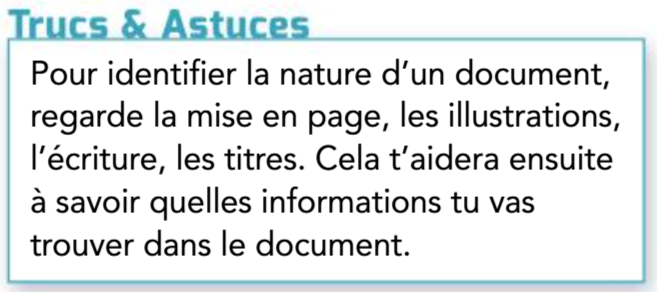
Have a look at the document below and say what it is.
What elements do you expect to find?
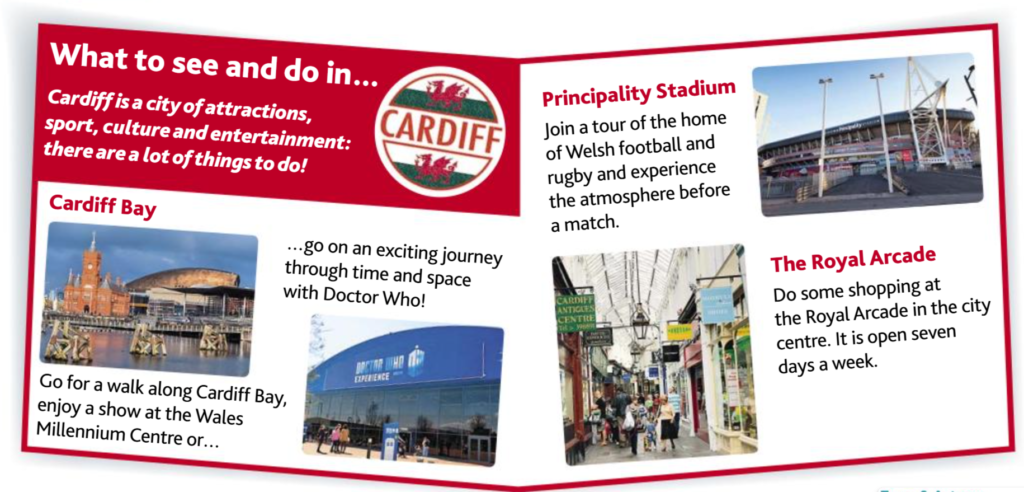
Any new vocabulary in this document?
Can you find the attractions on this map?
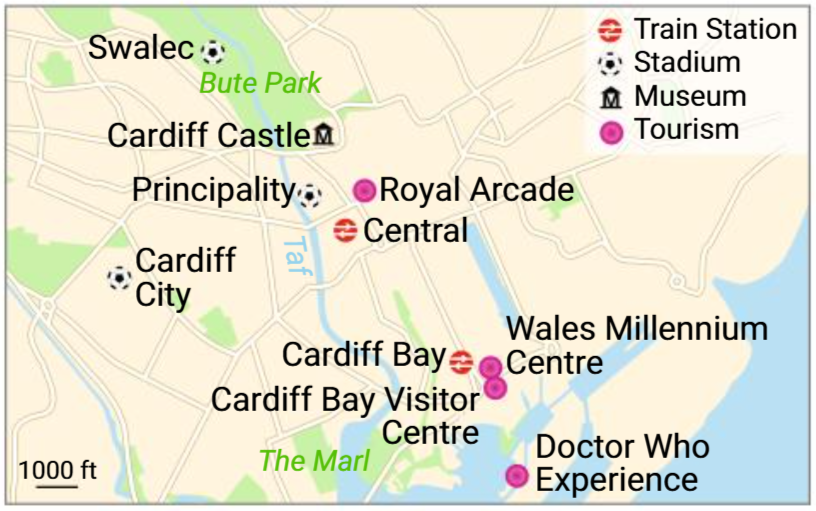

Complete the sentences to say what you can visit if….
If you are a rugby fan, you can visit Principality Stadium.
If you like shopping, you can …….
If you like walking, …….
If you are a science fiction fan …….
……. you love ……. , you ………….. Cardiff Castle.
………………………. , ………………… Cardiff City football stadium.
If you are a rugby fan, you can visit Principality Stadium.
If you like shopping, you can visit the Royal Arcade.
If you like walking, you can visit Cardiff Bay.
If you are a science fiction fan you can visit the Doctor Who Experience.
If you love history , you can visit Cardiff Castle.
If you love football, you can visit Cardiff City football stadium.
Cardiff Castle
Look at the photo and say what you can.
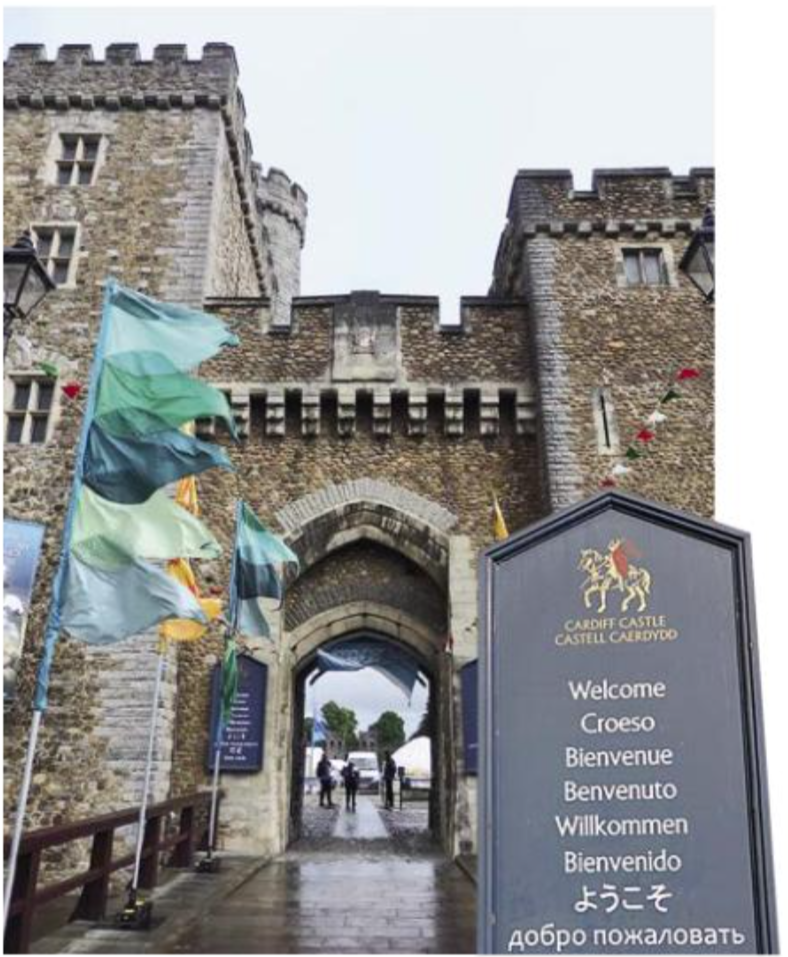
The photo shows Cardiff Castle. It’s an old medieval castle in the city of Cardiff. You can visit it. Tourists from all around the world visit this attraction because I can read « Welcome » in different languages.
1 – Listen, and point to all the places mentioned in the document.
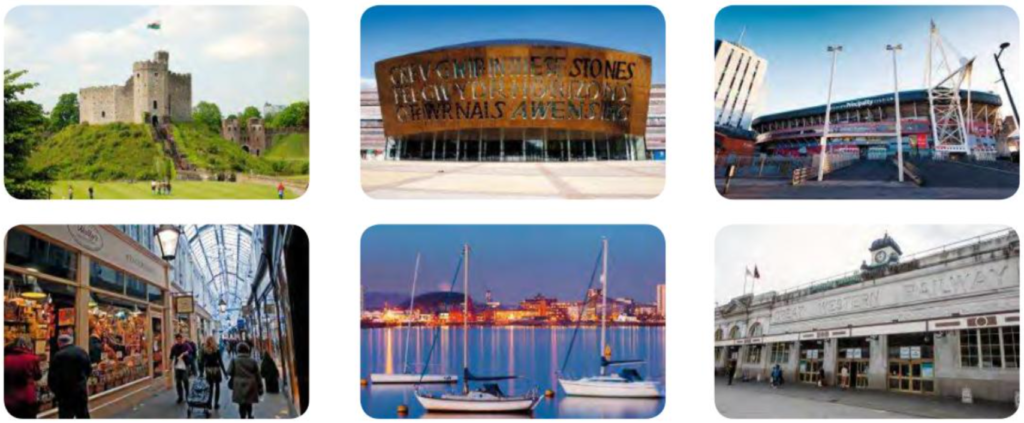
Cardiff Castle – Millenium Centre – Principality Stadium
The arcade – Cardiff Bay – The station
2 – Listen, again and write down all the words you understand or recognize.
3 – Now, use your notes and try to explain what the problem is.
The kids want to visit Cardiff Castle, but it’s too expensive. The kids only have £20, and one ticket for the castle costs £9.
4 – Now you know what the kids can’t do, write down what the kids can do.
- They can go shopping and buy gifts in the new shopping centre next to the station.
- They can go shopping in the city centre.
- They can walk to Cardiff Bay and eat Welsh cakes in the delicious coffee shop in the Millenium Centre.
- They can watch the rugby match on the big TV in the coffee shop.
Can et Can't

Observe le dessin, puis recopier les phrases avec les bonnes réponses.
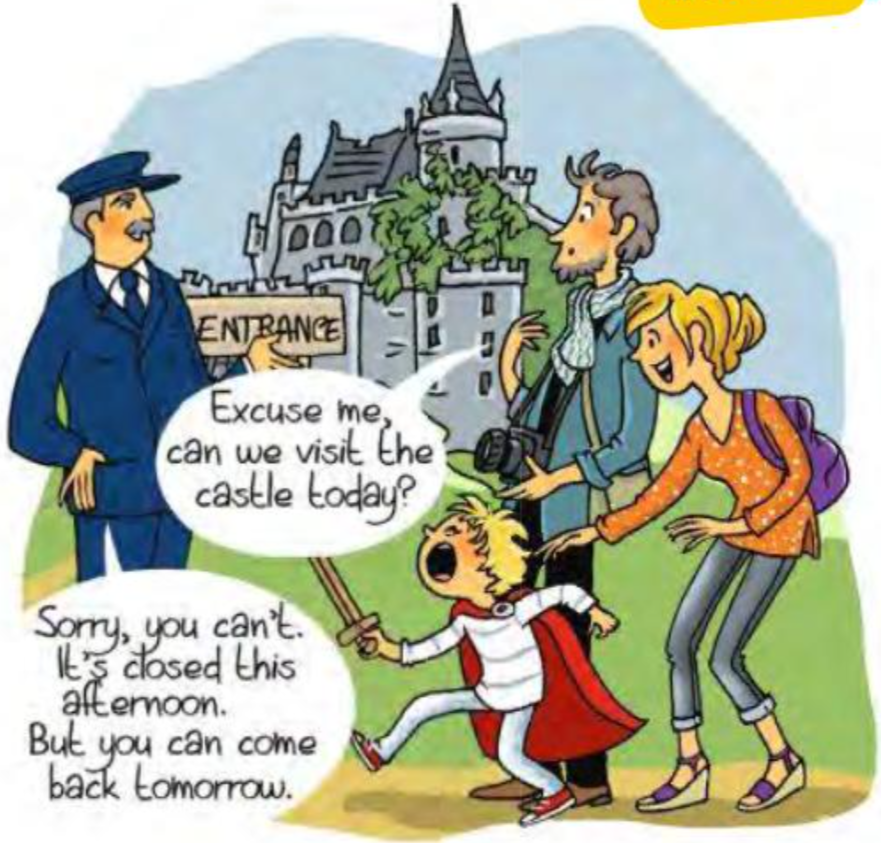
Pour dire que quelque chose est possible, on utilise can / can’t.
Pour dire que quelque chose est impossible, on utilise can / can’t.
Can est suivi d’un verbe conjugué / d’une base verbale / d’un verbe en -ing.
On utilise can et can’t à toutes les personnes.
Pour dire que quelque chose est possible, on utilise can.
Pour dire que quelque chose est impossible, on utilise can’t.
Can est suivi d’une base verbale.
On utilise can et can’t à toutes les personnes.
A la forme interrogative, on ……. the sujet et can.
A la forme négative, on ajoute la négation ……. à can (= ……. ).
Can est donc un auxiliaire / verbe. On l’utilise également dans les réponses courtes.
A la forme interrogative, on inverse the sujet et can.
A la forme négative, on ajoute la négation not à can (= can’t ).
Can est donc un auxiliaire. On l’utilise également dans les réponses courtes.
There is et There are
Observe les phrases ci-dessous puis copier le texte avec les bonnes réponses.
There is one cathedral in Cardiff.
There are two museums in Cardiff.
On utilise there is ou there are pour parler de ce que l’on possède / parler de ce que l’on peut faire / parler de l’existence de quelque chose.
Pour parler d’une seule chose, on utilise there is / there are.
Pour parler de plusieurs choses on utilise there is / there are.
L’auxiliaire be s’accorde / ne s’accorde pas avec le premier nom qui suit.
On utilise there is ou there are pour parler de l’existence de quelque chose.
Pour parler d’une seule chose, on utilise there is.
Pour parler de plusieurs choses on utilise there are.
L’auxiliaire be s’accorde avec le premier nom qui suit.
Observe les exemples ci-dessous et complète.
There isn’t a train station next to the castle.
Are there many museums in Cardiff? No, there aren’t.
A la forme négative, on ajoute la négation ……… à l’auxiliare be conjugué.
A la forme interrogative, on …….. le sujet there et l’auxiliaire be conjugué.
A la forme négative, on ajoute la négation not / n’t à l’auxiliare be conjugué.
A la forme interrogative, on inverse le sujet there et l’auxiliaire be conjugué.

The Doctor Who Experience
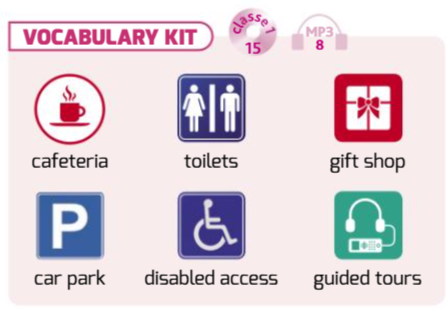
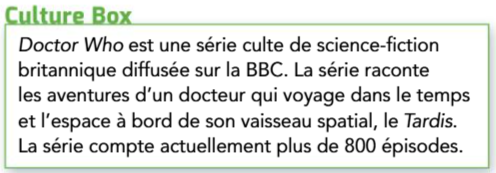
The Doctor Who Experience is a famous attraction in Cardiff.
Copy the table below.
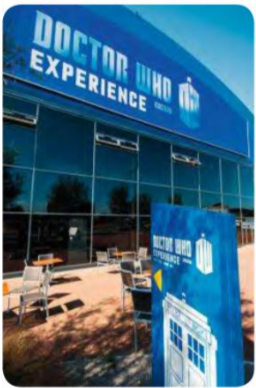

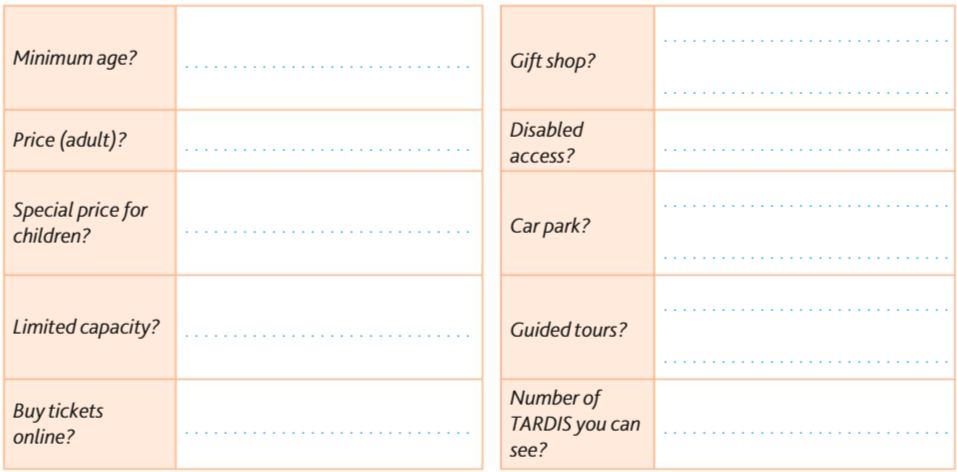
1 – Read the card that the teacher gives you, and fill in the information in the table.
2 – Prepare the questions you are going to ask to obtain the rest of the information.
- When can you visit the attraction?
- Are there special effects?
- What are the opening and closing times?
- Is there a cafeteria?
- Is there a minimum age?
- Is there a gift shop?
- How much does it cost?
- Is there disabled access?
- Is there a special price for children?
- Is there a car park?
- Is there a limited capacity?
- Are there guided tours?
- Can you buy tickets online?
- How many TARDIS can you see?
3 – Ask your questions to a classmate to get the rest of the information.
Worksheets
Complete the worksheet Cardiff Attractions.
a. capacité
b. possibilité
c. possibilité
d. capacité
a. I can’t go to the theatre because it’s closed.
b. Can you play rugby?
Evaluation
Answer questions about this lesson.
Famous Cardiff Attractions - Translation Evaluation
Quiz Summary
0 of 10 questions completed
Questions:
- 1
- 2
- 3
- 4
- 5
- 6
- 7
- 8
- 9
- 10
Information
You have already completed the quiz before. Hence you can not start it again.
Quiz is loading...
You must sign in or sign up to start the quiz.
Vous devez d’abord complété le suivant :
Résultats
Résultats
Your time:
Temps écoulé
Catégories
- Pas classé 0%
- 1
- 2
- 3
- 4
- 5
- 6
- 7
- 8
- 9
- 10
- Répondu
- Révision
-
Question 1 de 10
1. Question
J'ai deux oncles.
-
-
Question 2 de 10
2. Question
Alan est un garçon, mais Ceri ne l'est pas.
-
-
Question 3 de 10
3. Question
Es-tu gallois(e) ?
-
-
Question 4 de 10
4. Question
Je vois un train et un quai.
-
-
Question 5 de 10
5. Question
Vis-tu dans une maison ou un appartement ?
-
-
Question 6 de 10
6. Question
C'est le foyer du football gallois.
-
-
Question 7 de 10
7. Question
Le Royal Arcade est ouvert sept jours sur sept.
-
-
Question 8 de 10
8. Question
Si tu es fan de science-fiction.
-
-
Question 9 de 10
9. Question
Nous pouvons voir un spectacle au Millenium Centre.
-
-
Question 10 de 10
10. Question
Je vois un panneau de bienvenue.
-

